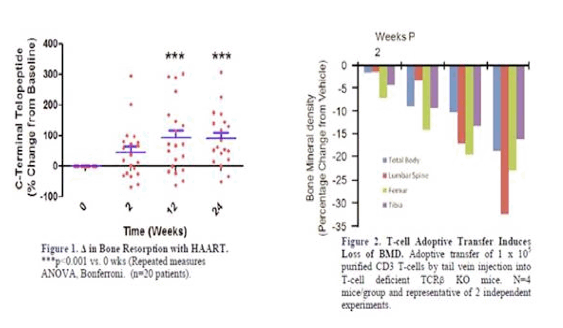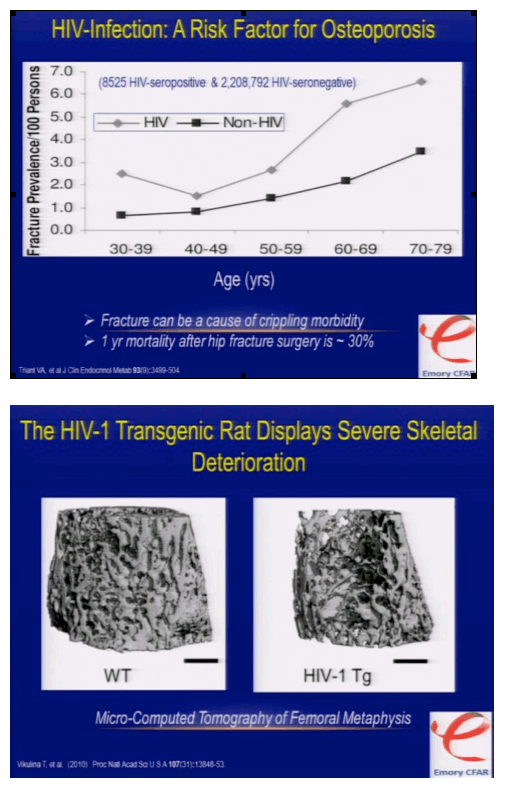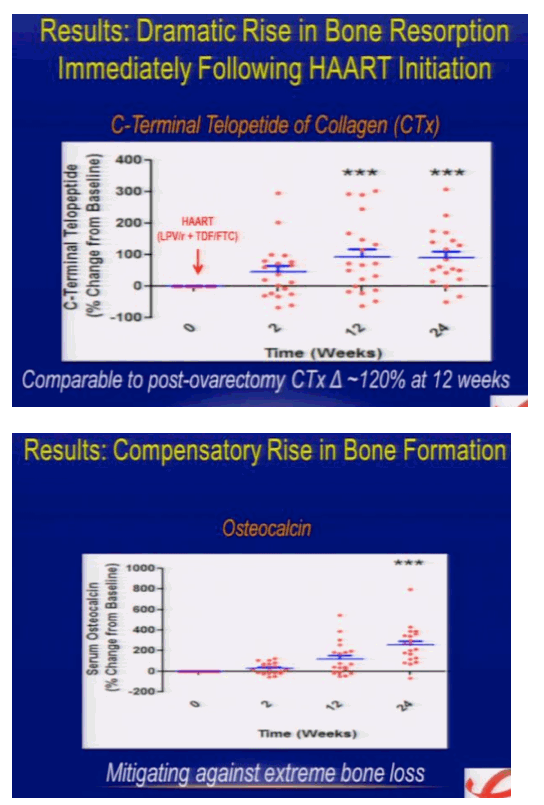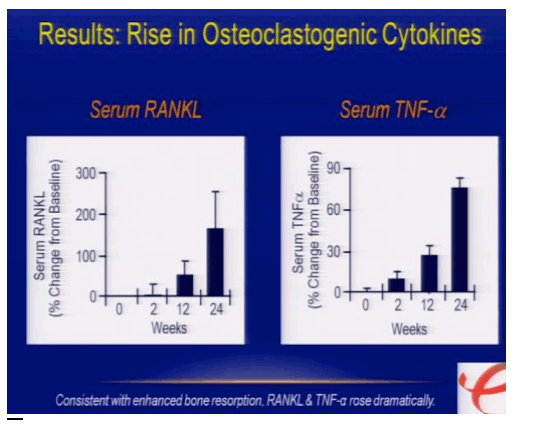 |
 |
 |
| |
HAART-induced Immune Reconstitution:
A Driving Force Behind Bone Resorption in HIV/AIDS
|
| |
| |
Reported by Jules Levin
CROI Feb 27-March 2 2011 Boston
Ighovwerha Ofotokun*, N Weitzmann, A Vunnava, A Sheth, F Villinger, J Zhou, E Williams, S Sanford, M Rivas, and J Lennox
Emory Univ, Atlanta, GA, US
Link to video presentation:
http://app2.capitalreach.com/esp1204/servlet/tc?c=10164&cn=retro&s=20445&&dp=player.jsp&e=13724&mediaType=podiumVideo
Background: Osteoporosis and fractures are serious complications of HIV/AIDS. Furthermore, HAART exacerbates rather than ameliorates to HIV-elated bone loss. Studies have shown ~6% reduction in bone mineral density (BMD) within the first 2 years of HAART, tapering off thereafter. In many pathologic conditions, activated T cells cause bone loss by secreting receptor activator of NF-kB ligand (RANKL). Importantly, T cell recovery with HAART reaches a significant magnitude within 12 weeks, prompting us to investigate whether HAART-related bone loss begins at a much earlier time point, and whether it is driven by a mechanism involving T cell reconstitution and activation, as a consequence of HAART to induced disease reversal.
Methods: As previous studies have concentrated on later time points (≥24 weeks) we prospectively examined changes in serum C to terminal telopeptide of collagen (CTx), an index of in vivo bone resorption, and the key osteoclastogenic cytokine RANKL at earlier time points (weeks 0, 2, 12, and 24) following HAART (lopinavir/ritonavir+tenofovir/emtricitabine) initiation in treatment-naive HIV patients. To evaluate a potential role of T cell reconstitution in bone loss, we mimicked HAART to induced disease reversal in vivo by means of T cell adoptive transfer into T cell null TCRb knockout mice and performed detailed skeletal phenotyping.
Results: Mean age (n = 20) was 40±11years, mean entry HIV RNA PCR (viral load) = log10 4.96±0.72 copies/mL, ∼CD4 T cell (week 0 to 24) =123±144 cells/mL. All but one had undetectable viral load at week 24. We observed an early surge in bone resorption, starting within 2 weeks, peaking at week 12 (mean ∼ from baseline = 93%, p <0.01), and remaining significantly elevated at week 24 (figure 1). Furthermore, RANKL was significantly elevated at week 24 (∼RANKL = 162%, p <0.001), explaining the surge in bone resorption. We next attempted to model these events by reconstituting T cells into T cell null mice and detected a surge in bone resorption (∼CTx = 120%, p <0.0001), concurrent with pronounced loss of bone mineral density (figure 2). This was associated with elevated RANKL (fold ∼ = 12.5) and TNFa (fold ∼ = 4.4), within the same 12-week window that resorption peaks in humans initiating HAART.
Conclusions: Our data suggest that HAART to related bone loss begins early during therapy as a consequence of T cell activation and reconstitution. It thus identifies a window where pre-emptive antiresorptive therapy could be applied to block skeletal decline following HAART.

Speaker comments: 'HIV is a risk factor for osteoporosis. Because of the young age grpup affected by this epidemic [HIV], the public health implication of HIV-related bone disease is currently grossly underestimated. Compared to HIV-negatives fracture risk is rising significantly with advancing age (look at this graph) for the HIV patient population. Fracture is not inconsequential, it can be a cause of crippling morbidity. In one year following fracture surgery mortality in first year can be as high as 30%, particularly in the elderly & immunocompromised individual. Understanding the pathogenesis or the mechanism is imperative to devising an effective remedy. There is a great deal of integration between the immune & skeletal system. Key cells regulating bone metabolism are regulated by the immunesystem. HIV-infection and other autoimmune diseases not surprisingly leads to significant bone metabolism disruptions and skeletal abnormalities. HAART exacerbates bone loss. HAART is now recognized as a risk factor for osteoporosis. They evaluated the bone profile in 20 treatment-naēve patients with LPV/r+TDF/FTC. We were surprised at our findings. A dramatic rise in bone resorption was immediately observed upon starting HAART. This began as early as 2 weeks, increased at 12 weeks and plateaued but remained elevated at 24 weeks. Of note 25% of patients had a rise of 200% or more from baseline to week 12 in CTx, a marker of bone resorption, these are huge changes, an order of magnitude one would expect in surgically induced menopause of women. Consistent with this huge increase in absorption, key osteoclastogenic cytokines serum RANKL & serum TNF-a were elevated explaining this loss. Luckily a compensatory rise in bone formation was also observed, osteocalcin, a marker of bone formation was markedly elevated, probably mitigating what would have been an extreme bone loss in these individuals. Because immune recovery with HAART reaches a significant level at about 12 weeks, the sae time point at which the observed peak in CTx occurred we hypothesized that bone resorption may occur through a mechanism involving T cell repopulation and reconstitution as a consequence of HAART-induced disease reversal. T cell reconstitution in immunocompromised mice mice led to similar reduction in bone mineral density as seen with HAART in HIV+ patients, this was also evident in significant bone structural abnormality in the bone of the T cell reconstituted mice. Similar to what we saw in humans, key markers of bone resorption were markedly elevated, serum RANKL & serum TNF-a were markedly elevated explaining the loss. IN SUMMARY, in humans following HAART initiation, early surge in bone resorption was observed with HIV disease reversal. In the TCR-beta knoeck-out mice T cell reconstitution led to a surge in resorption similar to the effect of HAART in human. TAKEN TOGETHER, our data suggests that HAART-related bone loss begins much earlier than previously suspected and may be driven by a mechanism of T cell reconstitution and osteoclastogenic cytokine production as a consequence of HIV-disease reversal. IMPORTANTLY, our data identifies an explorable window for pre-emptive intervention to block skeletal decline following HAART. A question after the talk asked if they checked for phosphate wasting in patients after starting HAART since tenofovir can cause phosphate wasting and a boosted PI may increase TDF levels & perhaps thus phosphate wasting and ths this may have contributed to the the results seen, in response the speaker said they are doing followup work to evaluate this and may do experiment again with a different HAART regimen. A good next question from Dan Kutizkes was if greater immune reconstitution in patients could be associated with greater bone abnormalities or bone loss and the speaker said ‘we see a significant trend’ suggesting I think that the supposition by Dan may be true but they will explore this in subsequent study since the numbers of patients were so small in this study. Todd Brown raised the concern that the exact opposite affect on cytokines have been seen in other studies and the speaker said perhaps some of this could be due to timepoints of measure as in those studies cytokine evaluations were done at later time points but then Brown said the opposite affect on RAKL was seen upon starting HAART and the speaker did not have an answer to that. Paddy Mallon said he saw similar results in his study reported in a poster here and they did not use TDF but he feels there is a contribution by ART depending on which ARTs are used.'



|
| |
|
 |
 |
|
|